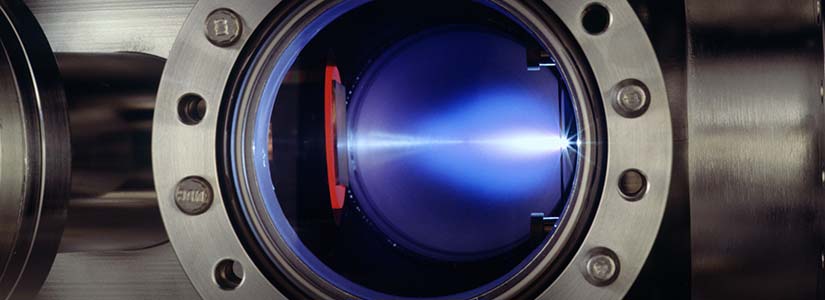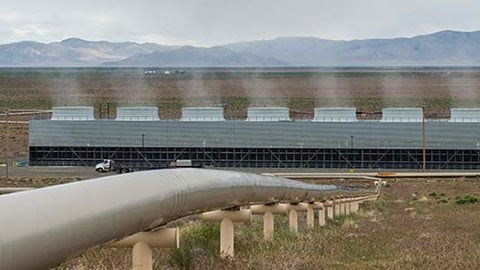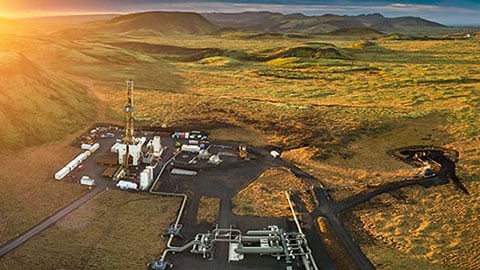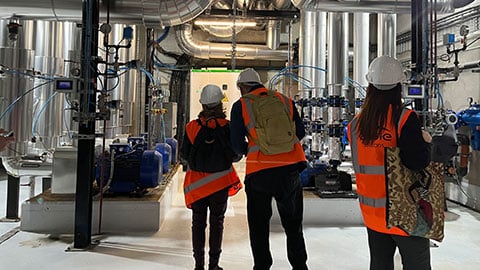Geothermal Resources and Technologies
NREL's research, development, demonstration, and deployment initiatives in geothermal technology are delivering innovative geothermal solutions to improve quality of life and move the world toward a sustainable energy future.

NREL is advancing science to expand the deployment of geothermal energy worldwide. Photo by Jim Yost, NREL
Learn more about our research and development activities in these geothermal technology areas:
Featured Projects
Learn more about each of the featured projects in the Fiscal Year 2024 Geothermal Accomplishments Report.
As part of the U.S. Department of Energy’s (DOE's) ongoing Energy Earthshots initiative, NREL conducted and published an analysis supporting the Geothermal Technologies Office’s (GTO's) Enhanced Geothermal Shot goals and targets. The results concluded that significantly expanding enhanced geothermal system (EGS) deployment by 2035 is ambitious but achievable with recent technological advances. Building on the 2019 GeoVision report, the 2023 analysis by NREL researchers Chad Augustine, Erik Witter, Sarah Fisher, and Jonathan Ho uses updated modeling assumptions and estimates of EGS resource potential to show that by 2050 the total amount of installed domestic geothermal capacity could reach 90 gigawatts-electric—nearly 25 times the current installed capacity.
View the full report.
Impact
Updated modeling and estimates of EGS resource potential show that by 2050 the total amount of installed domestic geothermal capacity could reach 90 gigawatts-electric—nearly 25 times the current amount generated.
In Fiscal Year 2023, the Geothermal Operational Optimization with Machine Learning (GOOML) project completed a digital platform that allows geothermal power plant operators to improve the efficiency of geothermal steam fields through the analysis of historical operational data and the application of custom machine learning algorithms. Geothermal Operational Optimization with Machine Learning brings together industry specialists from the United States and New Zealand on a GTO initiative to optimize geothermal operations through machine learning. This project was tested with data from three operating geothermal fields: Ormat’s McGinness Hills Geothermal Power Plant in Nevada, Ngāti Tūwharetoa Geothermal Assets Kawerau Geothermal Power Plant in New Zealand, and Contact Energy’s Wairakei Geothermal Power Plant in New Zealand.
Impact
On average, Geothermal Operational Optimization with Machine Learning showed a potential to improve availability factors of existing geothermal plants by 2%–10%.
Partners
Ormat Technologies Inc., Upflow Limited, Contact Energy Limited, and Ngāti Tūwharetoa Geothermal Assets Limited
NREL is providing geostatistical 3D modeling expertise to the INnovative Geothermal Exploration through Novel Investigations Of Undiscovered Systems (INGENIOUS) project, which creates risk reduction methodologies for geothermal power plant exploration. Hidden geothermal resources cannot be identified from surface expressions, so industry must rely on combined geophysical methods, qualitative geologic models, and sparse drilling information about depth to make assessments—leading to non uniqueness and low levels of confidence. This project is the first of its kind to fully integrate play fairway analysis, 3D and conceptual modeling, and resource capacity estimation to reduce uncertainty in prospecting for hidden systems.
Impact
Reduces risk for geothermal power plant exploration and development, which is a major barrier for geothermal technology uptake.
Partners
United States Geological Survey, Utah Geological Survey, Idaho Geological Survey, Lawrence Berkeley National Laboratory, Rasse Power Systems, Geothermal Resources Group, Hi-Q Geophysical, Aprovechar Lab L3C, Petrolern Ltd., and Innovate Geothermal Ltd.
NREL researchers are involved in two projects awarded under GTO’s Wells of Opportunity initiative, which explores the feasibility of utilizing existing oil and gas wells for geothermal energy. With few examples of active oil and gas wells being repurposed this way, the two Wells of Opportunity projects—Nevada and Oklahoma—are showcasing effective, cost-saving decarbonization measures that owners of oil and gas wells can implement.
Impact
This proof-of-concept project will support the implementation of geothermal energy production in existing oil fields, accelerating the energy transition and helping decarbonize the oil and gas industry.
Partners
Transitional Energy, Grant Canyon Oil and Gas, Electratherm, The University of Oklahoma, and Blue Cedar LLC.
NREL researchers have developed tools and models to simulate various types of advanced geothermal systems and assess their technical and economic performance for different subsurface, surface, and operating conditions. One such tool is the Slender-Body Theory Reservoir Heat Transfer Simulator. This model is based on the computationally fast slender-body theory, can handle multiple thermally interacting subsurface closed-loop heat exchangers with any geometry, and has been validated against finite element simulations.
The key benefit of this simulator is its ability to perform transient simulations over the reservoir lifetime (e.g., 20–30 years) in a matter of seconds, which allows scientists to quickly evaluate designs and conditions using a Monte Carlo-type approach. Although computationally fast, this simulator does have limitations. It does not account for geomechanical effects, requires uniform and homogeneous rock properties, and has limited ability to simulate coupled reservoir fluid convection. But high-performing geometries can be modeled using more complex reservoir modeling tools. This Slender-Body Theory tool is heavily deployed in investigating various closed-loop scenarios to assess sensitivity of different design parameters and determine the optimal well design to enhance energy extraction efficiency for advanced geothermal systems in real field scenarios.
Impact
If successfully developed and proven capable of cost-competitive heat extraction at demonstration sites, advanced geothermal systems could allow for safe, reliable, and scalable subsurface heat extraction anywhere in the world—resulting in new geothermal deployments worldwide.
Share
Last Updated Feb. 10, 2025




